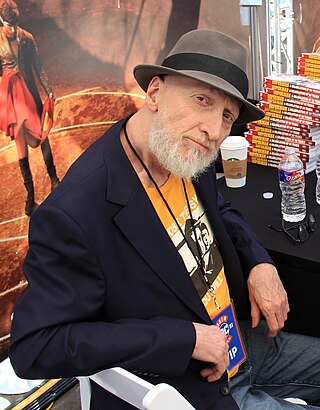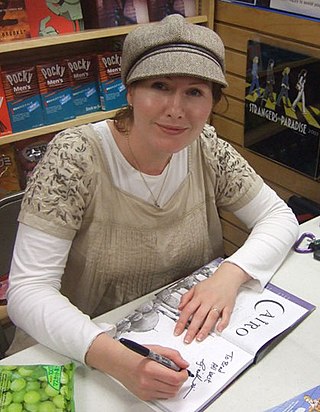
Frank Miller is an American comic book writer, penciller and inker, novelist, screenwriter, film director, and producer known for his comic book stories and graphic novels such as his run on Daredevil, for which he created the character Elektra, and subsequent Daredevil: Born Again, The Dark Knight Returns, Batman: Year One, Sin City, and 300.

A graphic novel is a long-form, fictional work of sequential art. The term graphic novel is often applied broadly, including fiction, non-fiction, and anthologized work, though this practice is highly contested by comics scholars and industry professionals. It is, at least in the United States, typically distinct from the term comic book, which is generally used for comics periodicals and trade paperbacks.

Colleen Doran is an American writer-artist and cartoonist. She illustrated hundreds of comics, graphic novels, books and magazines, including the autobiographical graphic novel of Marvel Comics editor and writer Stan Lee entitled Amazing Fantastic Incredible Stan Lee, which became a New York Times bestseller. She adapted and did the art for the short story "Troll Bridge" by Neil Gaiman, which also became a New York Times bestseller. Her books have received Eisner, Harvey, Bram Stoker, Locus, and International Horror Guild Awards.

David Chester Gibbons is an English comics artist, writer and sometimes letterer. He is best known for his collaborations with writer Alan Moore, which include the miniseries Watchmen and the Superman story "For the Man Who Has Everything". He was an artist for 2000 AD, for which he contributed a large body of work from its first issue in 1977.

Mark Farmer is a British comic book artist. He is best known as an inker, often working with Alan Davis.

Ed Brubaker is an American comic book writer, cartoonist and screenwriter who works primarily in the crime fiction genre. He began his career with the semi-autobiographical series Lowlife and a number of serials in the Dark Horse Presents anthology, before achieving industry-wide acclaim with the Vertigo series Scene of the Crime and moving to the superhero comics such as Batman, Catwoman, The Authority, Captain America, Daredevil and Uncanny X-Men. Brubaker is best known for his long-standing collaboration with British artist Sean Phillips, starting with their Elseworlds one-shot Batman: Gotham Noir in 2001 and continuing with a number of creator-owned series such as Criminal, Incognito, Fatale, The Fade Out and Kill or Be Killed.

John McCrea is a comic book artist best known for his collaborations with writer Garth Ennis.

Michael Mignola is an American comic book artist and writer best known for creating Hellboy for Dark Horse Comics, part of a shared universe of titles including B.P.R.D., Abe Sapien, Lobster Johnson, and various spin-offs. He has also created other supernatural and paranormal themed titles for Dark Horse including Baltimore, Joe Golem, and The Amazing Screw-On Head.
Guy Davis is an American creature designer, concept artist, illustrator and storyboard artist who has worked on film, television, comic book and video game projects. He is known for his collaborations with filmmaker Guillermo del Toro, including the television series The Strain (2014–17) and the films Pacific Rim (2013), Crimson Peak (2015) and The Shape of Water (2017). Beforehand, Davis was the regular artist for the Hellboy spinoff comic B.P.R.D. (2003–2010), as well as the artist behind his own creator-owned comic The Marquis (2009).

Paul Pope is an American alternative cartoonist. Pope's work combines the precision and romance of European comics artists with the energy and page design of the manga tradition. Pope's two protagonist types are the silent, lanky outsider male of One-Trick Ripoff, Escapo and Heavy Liquid; or the resourceful, aggressive, humorous young teenage girls of THB. He has self-published some of his work, most notably THB, through his own Horse Press, with other work for such publishers as DC Comics/Vertigo and First Second Books.

Brian K. Vaughan is an American comic book and television writer, best known for the comic book series Y: The Last Man, Ex Machina, Runaways, Pride of Baghdad, Saga, and Paper Girls.
Stuart Moore is an American writer and editor of comic books and novels.

"Letitia Lerner, Superman's Babysitter" is a comic book story by Kyle Baker, co-written with Liz Glass.
James H. Williams III, usually credited as J. H. Williams III, is an American comics artist and penciller. He is known for his work on titles such as Chase, Promethea, Desolation Jones,Batwoman, and The Sandman: Overture.

Joseph Kelly is an American comic book writer, penciler and editor who has written such titles as Deadpool, Uncanny X-Men, Action Comics, and JLA, as well as award-winning work on The Amazing Spider-Man and Superman. As part of the comics creator group Man of Action Studios, Kelly is one of the creators of the animated series Ben 10.
Shannon Eric Denton is an American veteran storyteller and artist with credits at Cartoon Network, Warner Bros., Jerry Bruckheimer Films, NBC, Disney, Sony, ToyBiz, Marvel Entertainment, Fox Kids, Paramount Pictures, CBS, Dimension Films, DC Comics, and Nickelodeon.

Matt Kindt is an American comic book writer, cartoonist, and graphic designer. His early creator-owned works were spy fiction, and their success led to mainstream work for hire projects in superhero fiction and other genres. His work has been nominated for Eisner Awards and Harvey Awards. In the comic industry, he is best known for his work on MIND MGMT, the Valiant Entertainment superhero universe, and BRZRKR, the first issue of which is the highest-selling single issue of the 21st century.

Gwendolyn Willow Wilson is an American comics writer, prose author, and essayist. Her best-known prose works include the novels Alif the Unseen and The Bird King. She is most well known for relaunching the Ms. Marvel title for Marvel Comics starring a 16-year-old Muslim superhero named Kamala Khan. Her work is most often categorized as magical realism.

Nathan Massengill is an American comic book artist, most known for his work as a brush inker. His work includes Marvel Comics' Deadpool and DC Comics' the Justice Society of America. He is best known for inking Ed McGuinness, penciler on the Deadpool series. He is also known for his inking work over pencilers Mike Wieringo, Dale Eaglesham, Steve Scott, and Sanford Greene.
Jason Temujin Minor is an American artist, writer, and comic book artist.
















